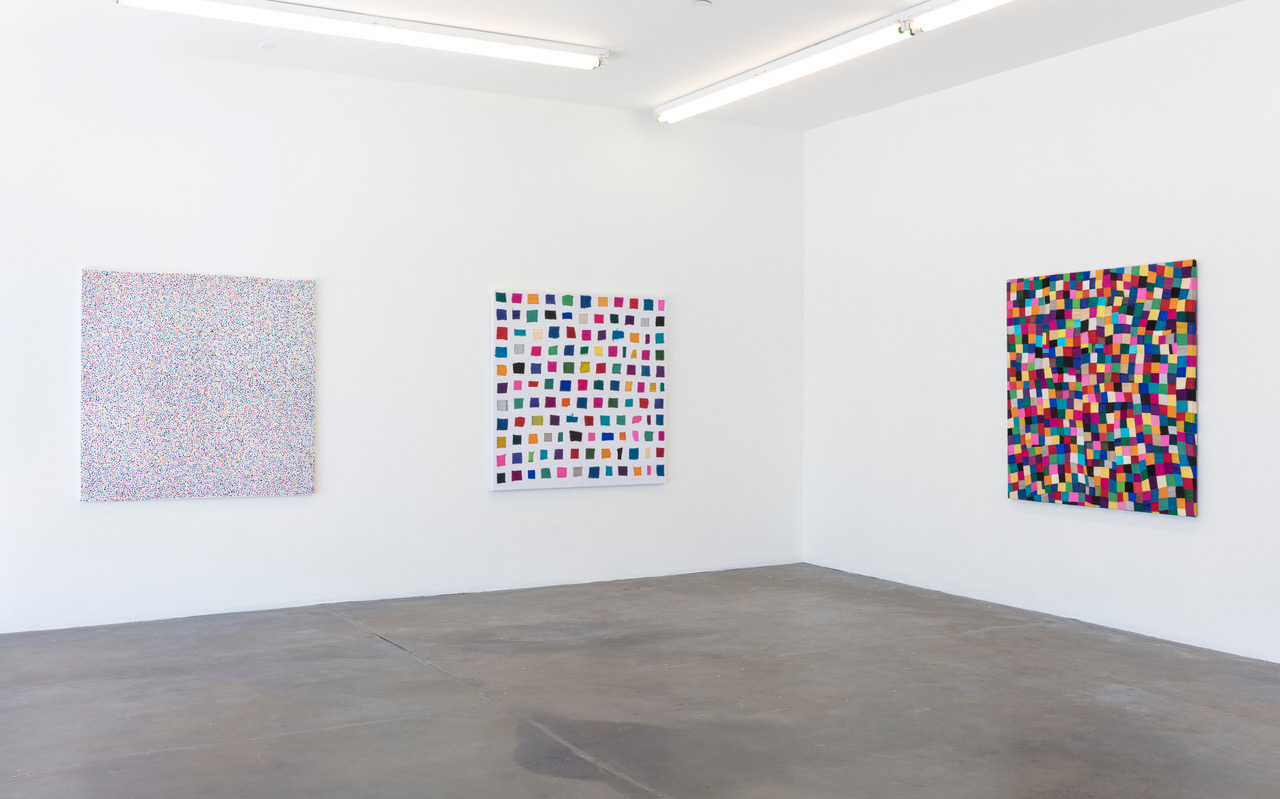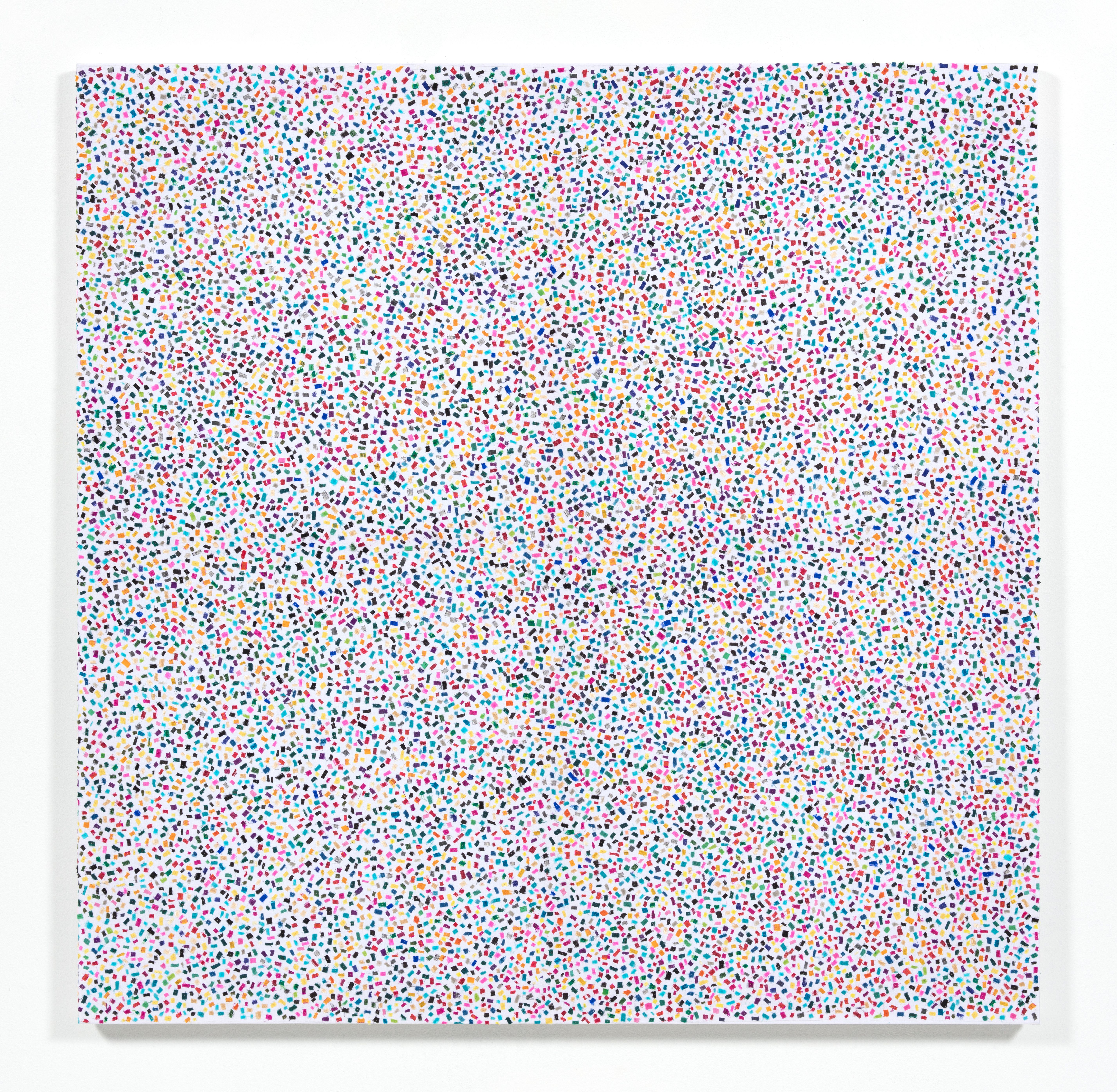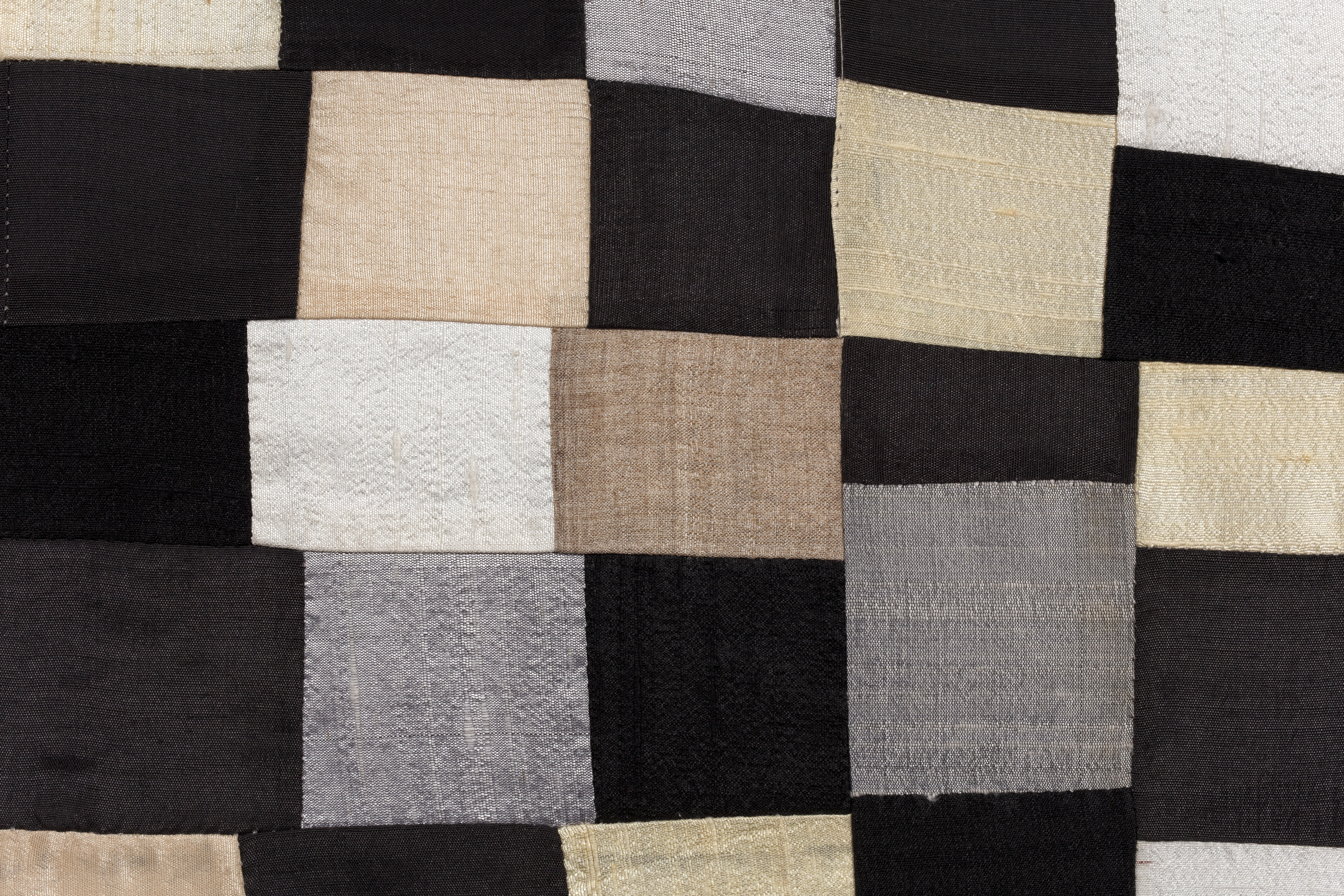EKTA AGGARWAL
TIME TRAVEL
Los Angeles | May 14 - July 9th 2022ARTFORUM MUST SEE
ArtandCake Review Shana Nys Dambrot


Rupture 2021 Small pieces of scrap fabric sewn on Khadi (hand spun cotton) 48 x 48 inches
“I started work on this series last year while I was based in Delhi and Emma in LA. She and I worked on this show across time zones communicating via WhatsApp and virtual studio visits.
Textiles serve as accumulators of time in my work pointing to the slow processes that make khadi, hand spun cotton that is the base of my paintings, the bit by bit accumulation of scrap fabric over time in my studio and the gradual build up of pattern on the surface of the paintings through the repetition of a motif by sewing, stitching and embroidery. As I work on these textiles with my hands holding them close to me, all the past experiences stored in my body, the thoughts going through my mind embed themselves into the patterns of these paintings transmuting these textile works into conduits of memory, portals to past, present and future.”
“Historically, pandemics have forced humans to break with the past and imagine their world anew. This one is no different. It is a portal, a gateway between one world and the next.”
-From The pandemic is a portal, Arundhati Roy
Ekta Aggarwal is a multidisciplinary artist based in Delhi. She has an MFA in Art from California Institute of the Arts, an MA in Fine Art from Chelsea College of Arts, University of the Arts London, and a BA (Honours) in Economics from Hindu College, University of Delhi. She has received several awards and scholarships, including the Diversity Grant, Provost’s Merit Scholarship and 2017 Hybrid Incubator for Visionary Entrepreneurs from California Institute of the Arts, Workshop with Hochschule Fur Bildende Kunste, among others. Ekta’s work has been shown at Five Car Garage, Monte Vista Projects, Ladies’ Room (online), Steve Turner Gallery and The Box Gallery. She has participated in residencies at The Joseph and Anni Albers Foundation, Virginia Commonwealth University School of the Arts in Qatar and the Bemis Center for Contemporary Arts.




-----------------------------------------------------------------------------------------------------------------------
Time Machines: On the work of Ekta Aggarwal
Scott Benzel
“Repetition changes nothing in the object repeated, but does change something in the mind which contemplates it. Hume’s famous thesis takes us to the heart of a problem: [...] given that repetition disappears even as it occurs, how can we say ‘the second,’ ‘the third,’ and ‘it is the same’? It has no in- itself. On the other hand, it does change something in the mind which contemplates it. This is the essence of modification.”
– Gilles Deleuze, Difference and Repetition
Humans have mastered one aspect of the art of time-travel. We can effortlessly, without technological augmentation, without any external apparatus, travel forward in time. In fact, we are compelled to do so. The future is always arriving, methodically, metronomically, on time. Try stopping it. Why is this apparently infinite series of one-way (exit?) doors so automatic as to be taken entirely for granted? Physicists and mathematicians have struggled with the compulsion of forward motion through time at least since Einstein’s teacher Minkowski conjoined “space” and “time” in “spacetime,” and found that the math works equally well in either direction (physics is famously time-symmetrical, its equations work equally well backwards as forward in spacetime). Per Einstein, a person/alien/whatever speeding away from Earth at the speed of light looks back and sees our past while a person speeding toward the Earth sees our future. Most of the stars that we see at night died billions of years ago. We can’t separate the milk from the coffee once its mixed in. And we can’t stop time or turn it back.
In 1997, the British experimental music group Coil recorded the album Time Machines. Each track is named for a drug: 7-Methoxy-B-Carboline (Telepathine), 5-Methoxy-N, N-Dimethyltryptamine, etc. These drugs are said to alter time, and the claim of the music is the same—the group’s goal with the album was “to cure you of time.” There are clues to each song’s desired effects in the choices of substances that they are named for: N-Dimethyltryptamine (DMT) is said to come on full-blown—a lightning-strike Blakean revery: “ To see a World in a Grain of Sand/And a Heaven in a Wild Flower/ Hold Infinity in the palm of your hand/And Eternity in an hour,” 1 while Telepathine (in addition to DMT, the active ingredient in ayahuasca) is reported to have the quality of a Laplacian demon-attack-cum-high-dimensional trash compactor—compressing time and information as the experiencer feels the universe flooding in: squeezing then exploding perception into a momentary “God’s-eye view.” The songs themselves are the sonic equivalent of moiré patterns: layers of repeating minimalist pulses and drones drifting in and out of sync with one another. Returning to Deleuze: “repetition changes nothing in the object or the state of affairs [...] a change is produced in the mind which contemplates: a difference, something new in the mind.”
The album’s conceit that a person can be “cured” of time suggests that time—contemporary clock-time in particular—is susceptible to alteration or suspension. The songs’ titling suggests that aesthetic phenomena contain somatic powers similar to those of powerful, mind-bending drugs. Michael Fried followed Denis Diderot in noting similar effects brought on by certain mid-18th century paintings. In Absorption and Theatricality, Fried suggests that the “perfect trance of involvement” brought on by the work of Jean- Baptiste-Siméon Chardin or Jean-Baptiste Greuze “rested ultimately upon the supreme fiction that the beholder did not exist, that he was not really there, standing before the canvas.” The paintings’ ability to “absorb,” to fix attention is, per Fried, a function of the works’ intensely internally focused content “and the causal and instantaneous mode of unity that came with it.” For Diderot, it is the work’s very
indifference that takes us out of time, momentarily transporting us into the time of the painting. The canvasses championed by Diderot usually depict their subjects’ absorption—the boy in Chardin’s The Card Castle (1737), is intensely focused on building a house of cards—suggesting that the weird powers of mimesis and psychological transference are somehow triggered as we become lost in the works.
1 From “Auguries of Innocence,” by William Blake.
Many an artist in their wasted youth has engaged in repetitive pattern-making brought on by a drug reverie or sheer boredom; the high school notebooks of artists and non-artists alike are full of them. The intuitiveness of this activity, the fact that generation after generation engage in it, might provide a hint to the inherent somatic power of the repetitive pattern to take us out of time. On a purely surface level, Ekta Aggarwal’s patterns and intense colors do exactly this.
But Aggarwal’s canvases and drawings also suggest another, deeper approach to time. From a later passage in Difference and Repetition: “The imagination is defined here as a contractile power: like a sensitive plate, it retains one case when the other appears. It contracts cases, elements, agitations or homogenous instants and grounds these in an internal qualitative impression [...] This is by no means a memory, nor indeed an operation of the understanding: contraction is not a matter of reflection. Properly speaking, it forms a synthesis of time” (italics mine).
The contractile power of Aggarwal’s work includes but extends beyond interweaving traditional Indian art and craft with Western modernist and postmodernist practices. The labor-intensive paintings, drawings, and textile works incorporate traditional patterns, designs, and materials sourced from traditional producers and production networks (the “canvas” support is Khadi, a locally-produced handmade cotton textile) as well as their contemporary equivalents— the grid, the mathematical object, the minimalist mark, synthetic paint, the pencil. Just as the work effortlessly contracts the affective distance between traditional and contemporary systems of representation and production, the intensive focus and labor apparent in its production contracts and materializes the time of artists and craftspeople, invoking the costs and pleasures of artistic labor; each work reflects and refracts labor-time, life-time, and the exceptional time set aside for culture– remnant of premodern ritual and carnival– designated a site out of time.
Words like contemporary, traditional, modern, postmodern, history, etc. are imbued with time to a degree that we mostly forget. Kant reminds us that Time itself is transcendental: the medium (and creator/destroyer) of all that is and can be, whereas time as we tend to think of it—clock-time, factory- time, free-time—is a recent invention, necessary to modernity’s processes of rationalization. Aggarwal’s work, with its complex patterning, complete or interrupted flows, variegated intensities and materials, and traditional and modern pictorial references, suggests that a moiré of timescales are always in effect; to paraphrase Bruno Latour, “We have never been entirely modern.”
The continuity between traditional and contemporary practices is most clear in Aggarwal’s work when she incorporates traditional patterns into repeating visual phrases not unlike those of Agnes Martin and other minimalists. But once again, there is difference: Aggarwal’s work subtly undermines the minimalists’ famous placidity and erasure of incident—some minor topological distortion is introduced or a full-scale “pattern interrupt” occurs. Often in Aggarwal’s work the effect results not from the incident- free “all-over” systems of the minimalists but from the successive, slow iteration or mutation of pattern, with each “phrase” mutating slightly, revealing itself to have grown from a “seed” within the previous mark . Zooming out, Aggarwal’s entire body of work similarly appears to evolve, with each work permutating from explorations undertaken in previous works.
This quality of Aggarwal’s practice—a body of work comprised of paintings and drawings that are at once precise and formally complete and exploratory, experimental, and sometimes wildly contingent—is
part of what gives it its unusual power: difference is always pushing out from between the cracks of repetition.
In the essay Shuttle Systems, Sadie Plant makes the case that the invention of the automated loom and traditional textile production’s transition to full automation reflected modernity’s paradoxical compression and continuation of deep time: “While the industrial revolution is supposed to have made the break between handheld tools and supervised machines, the handmade and the mass-produced, the introduction of technology to more primitive textiles techniques is both a break with the old ways and a continuation of the lines on which the women were already at work. Even before its mechanization, the loom was described as the “most complex human engine of them all.” Gandhi considered the production of Khadi an integral part of the Indian freedom struggle, calling it swadeshi (self-sufficiency) for the subcontinent. Grasping the historical processes behind Aggarwal’s material choices (Khadi as support, handmade textiles infused with locally-produced dyes, modern synthetics) is integral to understanding the work.
Plant goes on to emphasize the information-storage and time-contractive qualities of textile work: “Information can be stored in cloth by means of the meaningful messages and images which are later produced by the pen and the paintbrush, but data can also be woven in far more pragmatic and immediate ways. A piece of work so absorbing as cloth is saturated with the thoughts of the people who produced it, each of whom can flash straight back to whatever they were thinking as they worked. Like Proust's madeleine, it carries memories of an intensity which completely escapes the written word.”
Building on the “intensive data structure” of Khadi, Aggarwal infuses the work with similarly abstract- but-structured information: interference patterns composed of interlocking or overlapping histories and cultures, repeating forms, and actions with a nod to the trance-state of the high school notebook scrawler. Aggarwal’s work doesn’t stop time or cause it to flow backwards—it reminds us instead of the variability and multiplicity of times that we inhabit, contracting them, allowing us to step (perhaps only momentarily) outside of ordinary clock-time into the deeper time of reflection and absorption.

Pause 2021 Small pieces of scrap fabric glued and sewn on Khadi (hand spun cotton) 48 x 48 inches

details Pause

Solitude 2021 Small pieces of scrap fabric sewn on Khadi (hand spun cotton) 48 x 48 inches

detail Solitude

Rupture 2021 Small pieces of scrap fabric sewn on Khadi (hand spun cotton) 48 x 48 inches

detail Rupture

Stillness 2021 Small pieces of hand cut scrap fabric half circles appliqued on Khadi (hand spun cotton) 48 x 48 inches

Here, Now 2021 Small pieces of scrap fabric sewn on Khadi (hand spun cotton) 48 x 48 inches

detail Here, Now

Alone, Together 2021 Small pieces of scrap fabric glued and sewn on Khadi (hand spun cotton) 48 x 48 inches
